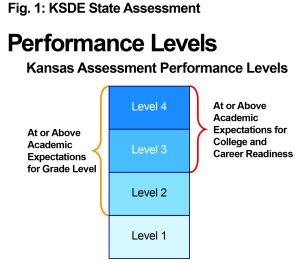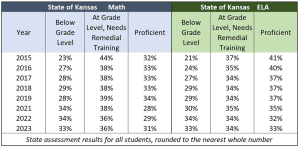(The Sentinel) — “Prairie Home Companion” on National Public Radio was about the fictional city Lake Wobegon, which host Garrison Keillor described as a place where “all women are strong, all men are good-looking, and all children are above average.” In the Kansas version of Lake Wobegon, with Education Commissioner Randy Watson as Keillor, all students are at grade level.
At the June 11 meeting of the State School Board, Watson said the current state assessment test does not include any reading or math questions regarded as below grade level or any above grade level. “The entire test is grade level,” he said.
Watson told board members that if they were asked what level is “grade level,” they should say that the entire test is grade level.
The Sentinel asked Watson how many Kansas students were below or above grade level, but he would not answer that question. He merely repeated the Lake Wobegon-like mantra of grade-level performance:
“The Kansas assessments are built on grade level standards for each grade and subject. The questions reflect a measurement of the knowledge and skills for that grade level and its content standards.”
Level 1 is below grade level
The current state assessment was implemented in 2015, and Department of Education (KSDE) officials used the adjacent graphic to explain how outcomes would be reported.
 Levels 2 through 4 are considered at or above academic expectations for grade level, meaning that students scoring in Level 1 are below grade level.
Levels 2 through 4 are considered at or above academic expectations for grade level, meaning that students scoring in Level 1 are below grade level.
In its March 2017 opinion in Gannon V, the Kansas Supreme Court noted that a quarter of students were below grade level on the state assessment in 2016 – a clear reference to students scoring in Level 1. In math, 27% were below grade level, and 24% were below grade level in English Language Arts (ELA).
As parents and legislators became more aware of that shocking statistic, KSDE modified the descriptions and removed the words ‘grade level.’
- Level 1 – students have a limited ability to understand and use material needed for post-secondary success.
- Level 2 – students have a basic ability…
- Level 3 – students have an effective ability…
- Level 4 – students have an excellent ability…
KSDE tells the U.S. Department of Education that students in Levels 3 and 4 are proficient and at or above expectations for college and career readiness.
 The 2023 state assessment shows 33% of students are in Level 1 with limited ability to read, but Watson wants you to believe that those kids are at grade level, just like the 33% of students who are proficient and have effective or excellent reading ability.
The 2023 state assessment shows 33% of students are in Level 1 with limited ability to read, but Watson wants you to believe that those kids are at grade level, just like the 33% of students who are proficient and have effective or excellent reading ability.
Rather than admit that a quarter of students were below grade level and take corrective action, KSDE, the State School Board, and the Kansas Association of School Boards (KASB) try to gaslight parents and legislators.
But they aren’t fooling anyone.
Senate Education Committee exposes gaslighting
On February 10, 2022, Mark Tallman, Associate Executive Director of Advocacy for the Kansas Association of School Boards, testified before the Senate Education Committee, during which he said the achievement of grade level on the state assessment is not defined. Committee Chair Sen. Molly Baumgardner wasn’t buying it.
“Mr. Tallman, did I hear you say there are no standards for grade levels?” she asked.
He chose his words carefully in responding: “No, what I’m saying is at least my understanding now is the state reports four benchmark levels. One, two, three, and four. There are descriptors of each of those levels, but there is not one that is referred to as being on grade level. I think people generally colloquially refer to like two and above as being on grade level, and three and above as being college and career-ready, but if you look on the [KSDE] website, unless something has changed, those specific [grade level] labels are not attached.”
Baumgardner pushed back, asking, “Then what the heck would third-grade reading competency be?”
Tallman didn’t have an answer but deflected, saying, “I think that would have to be defined as ‘what do you mean by that?’ Do you mean Level 2, do you mean Level 3?”
Baumgardner continued her cross-examination: “This is coming from the Department of Education Kansas Can outcomes. So are you telling me that the State Board of Education hasn’t defined what third-grade reading competency is? Is that what we’re supposed to believe?”
Tallman replied, “My understanding is that if you look at their definition . . . they have a definition of what Level 2 means or Level 3 means . . . none of those definitions include the phrase ‘grade level.’”
Student achievement can’t change until adult behaviors change
Watson’s and KASB’s obvious attempts to deny the reality of low student achievement for many students would be hilarious modern-day versions of The Emporer’s Clothes if the subject was not so serious.
The moral of the story is clear – most education officials want students to do better, but not if they must accept responsibility and change their behaviors.
Two state audits have concluded that school districts are not spending over $500 million in state funding intended to improve outcomes for at-risk students as required in state law, and state legislators are fully aware of these findings. They also know that the State Board of Education has allowed illegal activity to continue even though districts must comply with state law to be accredited.
Legislation was introduced this year requiring the State Board to strip accreditation from districts that flout state law, but many legislators didn’t want to vote on it in an election year, so the bill died in committee.
Many state and local education officials repeatedly demonstrate that they are unwilling to change their behavior to improve student outcomes, and that won’t change until enough legislators are willing to risk losing an election to hold the system accountable.

